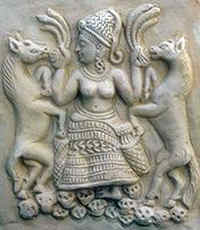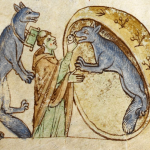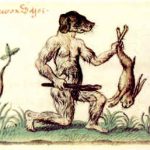Lupercalia
Lupercalia was celebrated in parts of Italy and Gaul; Luperci are attested by inscriptions at Velitrae, Praeneste, Nemausus (modern Nîmes) and elsewhere. The ancient cult of the Hirpi Sorani (“wolves of Soranus”, from Sabine hirpus “wolf”), who practiced at Mt. Soracte, 45 km (28 mi) north of Rome, had elements in common with the Roman Lupercalia.

The Romans themselves attributed the instigation of the Lupercalia to Evander, a culture hero from Arcadia who was credited with bringing the Olympic pantheon, Greek laws and alphabet to Italy, where he founded the city of Pallantium on the future site of Rome, 60 years before the Trojan War. Lupercalia is connected with the Ancient Greek festival of the Arcadian Lykaia, a wolf festival (Greek: λύκος, lýkos; Latin: lupus), and the worship of Lycaean Pan, assumed to be a Greek equivalent to Faunus, as instituted by Evander.
The Lupercalia had its own priesthood, the Luperci (“brothers of the wolf”), whose institution and rites were attributed either to the Arcadian culture-hero Evander, or to Romulus and Remus, erstwhile shepherds who had each established a group of followers. The Luperci were young men (iuvenes), usually between the ages of 20 and 40. They formed two religious collegia (associations) based on ancestry; the Quinctiliani (named after the gens Quinctia) and the Fabiani (named after the gens Fabia). Each college was headed by a magister.
At the Lupercal altar, a male goat (or goats) and a dog were sacrificed by one or another of the Luperci, under the supervision of the Flamen dialis, Jupiter’s chief priest. An offering was also made of salted mealcakes, prepared by the Vestal Virgins. After the blood sacrifice, two Luperci approached the altar. Their foreheads were anointed with blood from the sacrificial knife, then wiped clean with wool soaked in milk, after which they were expected to laugh.
The sacrificial feast followed, after which the Luperci cut thongs (known as februa) from the flayed skin of the animal, and ran with these, naked or near-naked, along the old Palatine boundary, in an anticlockwise direction around the hill.In Plutarch’s description of the Lupercalia, written during the early Empire,
…many of the noble youths and of the magistrates run up and down through the city naked, for sport and laughter striking those they meet with shaggy thongs. And many women of rank also purposely get in their way, and like children at school present their hands to be struck, believing that the pregnant will thus be helped in delivery, and the barren to pregnancy.
The Luperci completed their circuit of the Palatine, then returned to the Lupercal cave.








